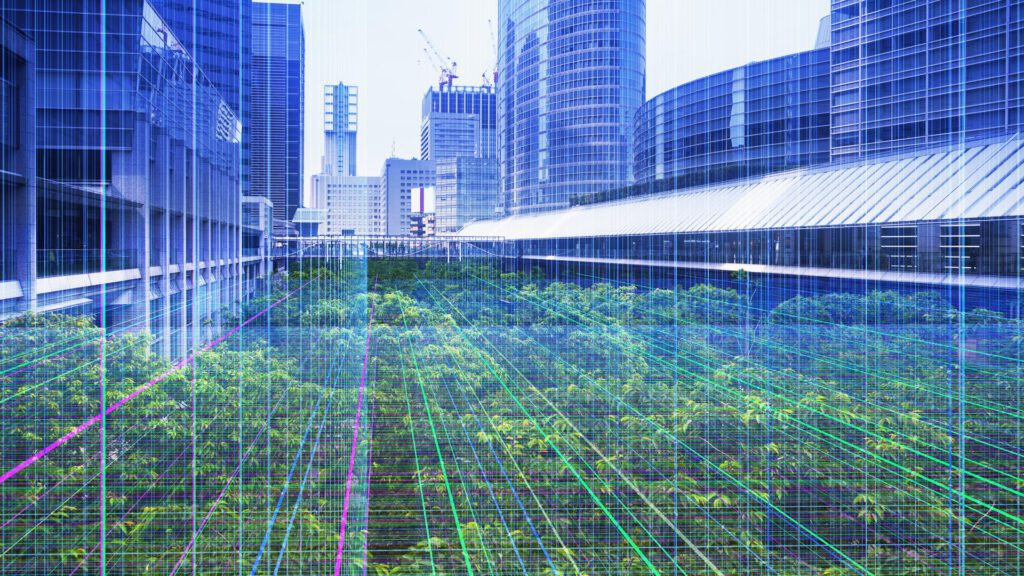Today’s buildings are smart and getting even smarter. The adoption of Internet of Things (IoT) devices and the move to cloud-based technologies are both advancing at a rapid clip. It is reported that the market for building-related IoT grew 21% between 2019 and 2021, and their analysts anticipate a 12% annual growth through 2027. That translates to 2.5 billion connected devices in commercial buildings alone.

These devices are part of an accelerated drive to make buildings more sustainable by providing real-time data on conditions, systems performance, and the ability to automate control systems.
The World Economic Forum (WEF) estimates that digital technologies, at scale, could deliver 1/5 of the emissions reductions needed to hit net-zero targets by 2050. But, while that date is decades away, we must increase the adoption of new technologies to make that goal achievable.
Artificial intelligence (AI) and machine learning (ML) are critical elements in helping building owners and operators use their IoT data more efficiently to decarbonize their facility’s operations. These technologies can analyze and act on the vast amount of data that IoT devices generate in microseconds, streamlining building automation.
How AI and ML can drive decarbonization through reduced energy demand
A recent installation for SISAB, the owner/operator of most of Stockholm’s school buildings, illustrates the potential of AI and ML to work together to cut both buildings operating costs and related emissions without compromising comfort.
The company recognized it faced three specific challenges that were standing in the way of accomplishing these goals:
- Energy inefficiency that was leading to high utility costs
- A complex building automation system architecture
- An inability to collect, analyze and act on the huge amount of data its systems were already generating
In 2013, SISAB centralized its control systems into a single station responsible for maintaining the 624 buildings serving 200,000 students and staff at a comfortable 20°C. However, a significant roadblock was its inability to handle the data delivered by the 20,000 temperature and humidity sensors installed throughout this extensive network to maximize its heating systems’ performance.
So, SISAB turned to Schneider Electric’s EcoStruxure Building Advisor solution to leverage EcoStruxure Building Operation with AI powered by Myrsproven to make that data work in their favor.
Comparing pre-installation energy bills from two winter seasons, SISAB has seen the following improvements:
- 4% heating energy savings
- 15% electricity savings
- 205-tonne reduction in greenhouse gas emissions
- 23% reduction in complaints from building occupants.
The new system investment paid for itself in just two years, modeling how companies can use energy savings to pay for similar improvements and, over time, extend their operational budgets for other sustainability efforts.
SISAB’s improvements were achieved because the AI-based system recognized building occupancy rates were higher at certain times. The system could then dial back on supply heat based on occupancy patterns during winter, recognizing that body heat could make up the difference. It could also mean pre-cooling spaces ahead of anticipated peak-demand periods in warmer months so energy use doesn’t spike as temperatures climb and spaces can remain comfortable.
With AI, meeting these goals can now happen without needing ongoing maintenance personnel involvement. AI models automatically and continuously learn and adapt their control strategy to the changing dynamics of a building.
While other AI solutions may require custom programming to build a model from scratch, Myrspoven software installs a generic “out-of-the-box” model with no human programming. Instead of running on schedules, the AI model is provided input values and a specific output/goal to reach, using supervised learning and other AI techniques. In essence, the generic model learns by making changes to the system and observing the result, transforming into a tailored model fit for a specific building.
The power of partnership
The stakeholders in this project – SISAB, Schneider Electric, and Myrsproven – learned some lessons through this implementation. These tips could be helpful to others considering a similar upgrade:
- Establish a tight collaboration between partners. Stakeholders should expect a steep learning curve, but a close working relationship can help quickly resolve any questions.
- Choose an open building management system (BMS), like EcoStruxure Building Operation, to help avoid complex integrations into your current infrastructure.
- Integrate AI into the BMS interface This will help operators and technicians to better understand and make real-time adjustments.
- Avoid aggressive control overrides and bypasses to prevent mechanical damage. Large and frequent set point changes can cause wear on actuators, negatively impacting occupant comfort.
Learn more
To learn more about how AI improved SISAB’s operations – and how it could also help yours – download our white paper on the project.



